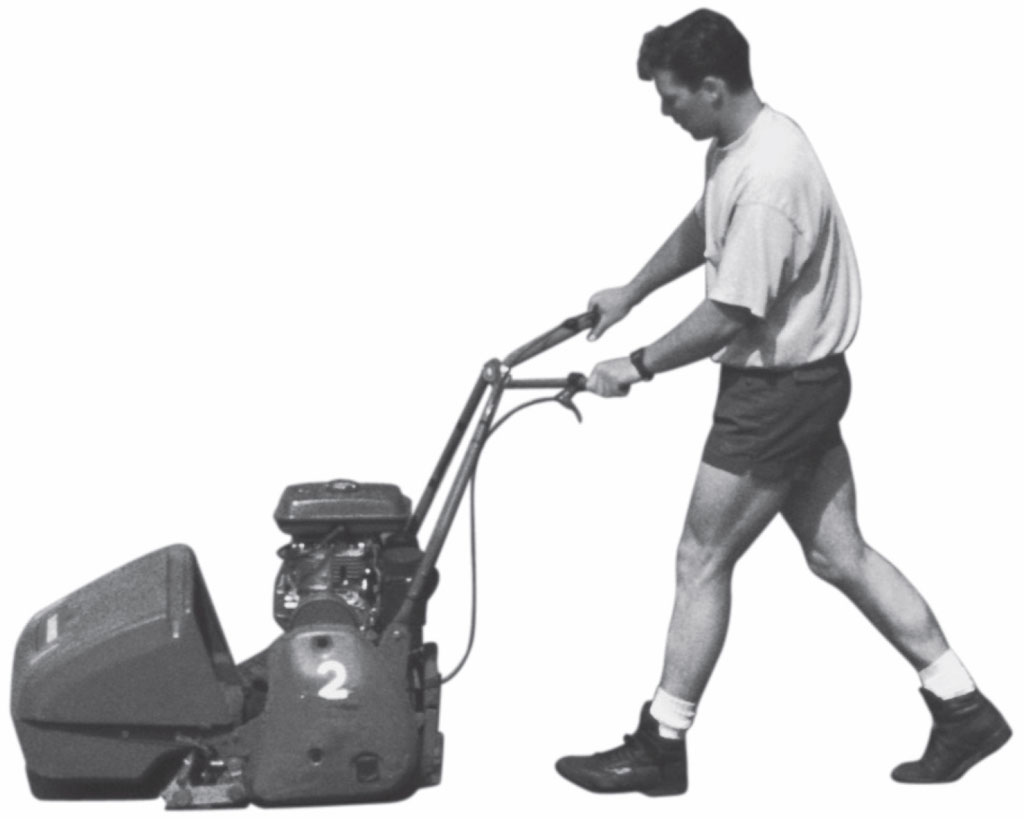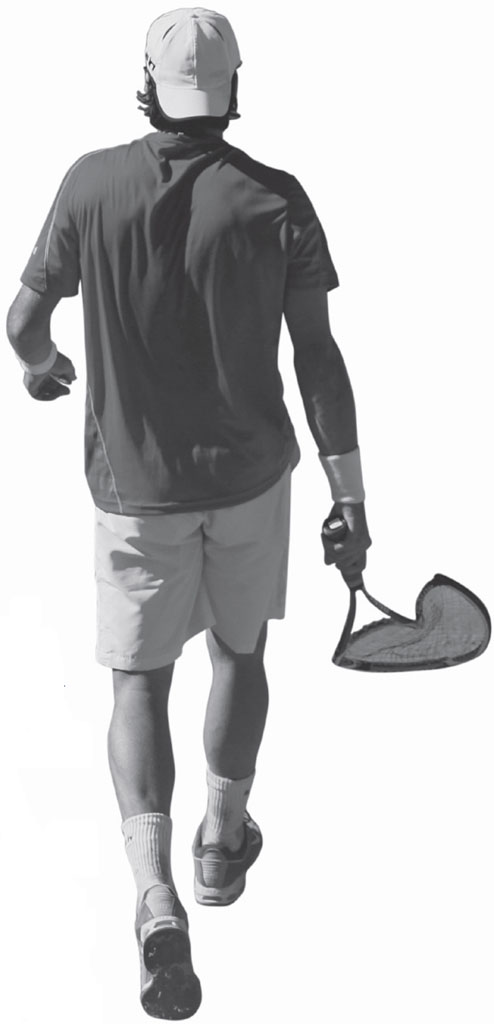
Dmitry Tursunov, who has been ranked in the world’s top 20, on ‘HOW TO SMASH A RACKET’ …
Embrace it: ‘I think more of the top players should be encouraged to smash rackets. They are trying to show how intense and passionate they are on court, and what better way to do that than destroying rackets?’

Don’t ever throw the racket: ‘If you hold on to it, you feel more in control, it’s really you smashing the racket, you can feel it breaking, you can feel the vibrations and the force down your arm. Also, if you throw your racket across the court, and it doesn’t break, and there’s only a scratch on it, then you are going to feel like an idiot when you walk over to pick it up.’
Breaking a racket on grass earns you extra style points: ‘I’m impressed by anyone who can break a racket on a grass court. That’s really manly, but it’s difficult. You could just end up with a big divot in the grass. I remember doing it once on grass when I was really pissed off, and it ended up sticking out of the grass like a spear.’
Practise, practise, practise: ‘You have to get your racket-smashing right on the practice court. You don’t want to look stupid when playing matches.’
Deal with the remorse: ‘Afterwards, you feel a bit sorry that you’ve done it, and you’re like, “Yeah, I’ll make it up to you darling, my little racket.” But the racket is broken and you know that it’s never going to be the same again.’

Goran Ivanisevic, a former Wimbledon champion, on ‘WHY SMASHING RACKETS IS A GOOD THING’ …
Ignore the boos from the crowd: ‘The people booing you, they’ve probably been complaining that people haven’t been breaking rackets, and that tennis is too boring, and there are no characters. Then they’re not happy when people are breaking rackets. I mean, what the f***. They should make up their minds. If you want to break a racket, you should be allowed to break a racket. If, like me, you have a talent for it, you can break your racket on any surface – I can break a racket on water.’
You have to move on immediately – break the racket and then forget about it: ‘It’s not a problem smashing rackets. If you want to smash the racket, smash the racket, and take a new one, but forget about the one you’ve just smashed. A lot of the time, I would smash the racket and then I would spend the next five games thinking about the racket. I was thinking, “Why did I break that racket? Should I have broken that racket?” That was my mistake, thinking about it too much. If you want to break the racket, just break the motherf***** and stop thinking about it. Take a new one and just forget about it.’
But make sure you don’t smash all the rackets in your bag: ‘I was the first person to lose a match because I had smashed everything and run out of rackets. It wasn’t that satisfying. The moment I broke the last racket, I was happy. And then I realised, “F***, I don’t have any more rackets.” And I felt stupid.’

Venus Williams, who has won 8 grand slam titles, and who has her own clothing range, on ‘HOW TO BE STYLISH ON COURT’ …
Figure out what looks good for your body type: ‘Not everyone can wear everything so you have to work out what works for you. If you don’t find something that looks good on you, the joke is going to be on you.’
Wear what excites you: ‘Tennis fashion has changed a lot in the last 10 or 15 years and has become more interesting. The future remains to be seen. Tennis is conservative, and tennis style is probably never going to be on the runways, but that doesn’t mean it can’t be exciting as well.’
Don’t underestimate the importance of looking good on the court: ‘Absolutely you will play better tennis if you feel good about what you’re wearing. You will feel confident and you won’t have to worry about what you’re wearing and you can focus on your game. But if you don’t feel good about what you’re wearing, you will be constantly thinking, “I look terrible.”’
Listen to your friends’ opinions: ‘Be willing to take some constructive criticism. Your real friends will help you out.’

Bethanie Mattek-Sands, who has been called the Lady Gaga of tennis, on ‘HOW TO DRESS TO IMPRESS’ …
Be bold: ‘It’s a huge compliment that people call me the Lady Gaga of tennis. She has rocked some bizarre stuff. I would consider wearing a dress made out of meat, like Lady Gaga did, but it’s tough to repeat something like that. Also, I need to be able to move and sweat on court, so I can’t be as extreme as she is.’
Keep everyone guessing about what you’re going to wear, and never wear the same thing twice: ‘I wore a dress made out of tennis balls to a pre-Wimbledon party, and my husband thought I should wear it again, but you can’t do that. The Wimbledon Museum have asked for it, but it’s kind of special to me. I’m keeping it for now. People come to the house to try it on. The year that I wore knee-high socks at Wimbledon, the museum asked for those after the match, and I gave those to them. I was playing Venus Williams on Centre Court and I thought I was in trouble as an official came up to me and said: “Hey, we need to talk to you about your outfit.” I thought I was about to get fined. There was real relief when they said, “Could you donate your outfit to the museum?”’
There’s no harm in wearing things to win bets, or in just wearing the first thing you find in your suitcase: ‘I once wore a cowboy hat on court. That was a dare by an ex-boyfriend. He didn’t think I would do it. I was cut from my sponsor just before going to the Australian Open one year. I had all this stuff from the company with me and I was thinking, “I just got cut, I don’t want to wear this,” and so I had a dig around in my suitcase … and that’s what I wore on court. I played in the hat and got fined for it. I’m not sure whether I would do that again – I was fined a thousand dollars. They said it was non-tennis attire. I’ve worn a lot of leopard-print stuff. I had a hot-pink leopard-print dress. I’ve worn a leopard print headband. My doubles partner, Sania Mirza, has said of my fashion sense, “No way could you pay me enough money to dress like Bethanie.”’
Have fun with your fashion but don’t let it distract you once the match starts: ‘Once I’m on the court, I don’t think about what I’m wearing. It’s all business. I’m there to win a tennis match. Having fun with my outfits and my hair or tattoos, that’s my personality, and it’s relaxing. It gets my mind off the tennis, it’s fun, and then I focus once I get on the court. Before going on court, I make sure that everything fits OK, and isn’t going to restrict my movement or vision. You don’t want to be worrying about that, as that would be a distraction. When I wore the cowboy hat, it was pinned on, so I could see everything.’
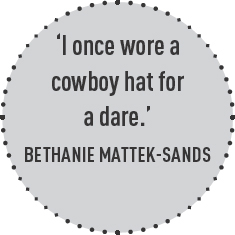

Ana Ivanovic, a former French Open champion and world No. 1, on ‘HOW TO PACK YOUR RACKET BAG’ …
Consider packing rackets strung at two different tensions: ‘I usually carry about five rackets, strung at two different tensions: four at my regular tension and one tighter. I may change to a more tightly-strung racket depending on the conditions or if I feel my timing is a little off on that particular day. If the conditions are hot and the ball is flying quickly through the air, a tighter racket would be needed. But it’s rare that I would change it mid-match, because I practise about 90 minutes before the match, so I know what conditions to expect. But conditions can change, and it’s good to have that option.’
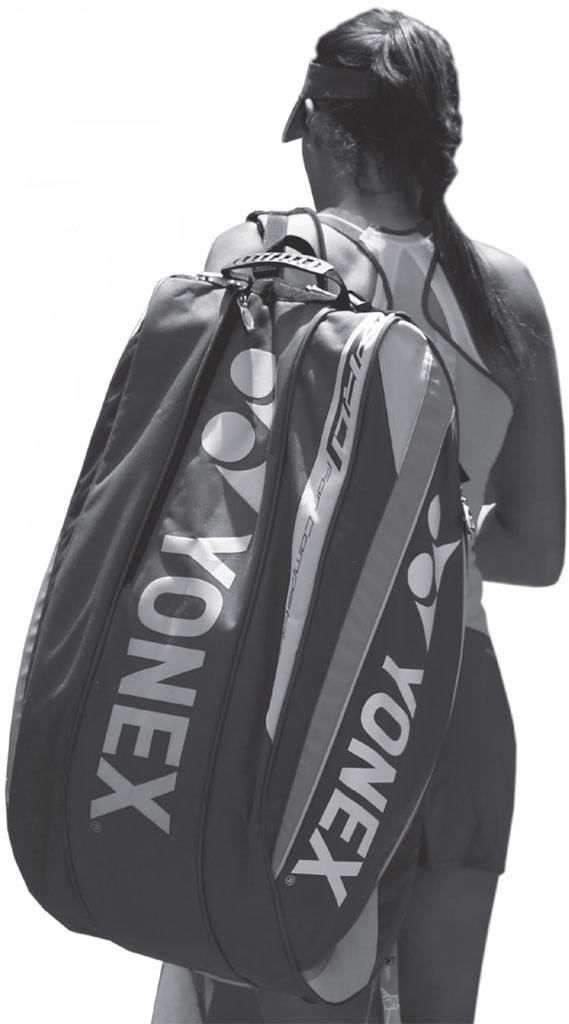
Pack a sports drink filled with electrolytes, and a banana, and some power bars. Avoid chocolate and fizzy drinks: ‘A sports drink filled with electrolytes will keep you well hydrated. But you don’t always have to buy a sports drink – I know they can be expensive. Instead, you could buy some electrolyte tablets or powder that you dissolve in water. A banana quickly releases energy, and power bars are also good to give you a boost of energy during a changeover. Avoid foods with high fat and sugar content, like chocolate. And fizzy drinks aren’t good either, because they can cause you to become bloated: water is far better.’
Some players like to take lucky charms or mascots on court: ‘In the past I carried lucky pennies.’
Don’t forget a spare outfit and a towel: ‘At professional tournaments, we can always ask the ball boys for a towel. But I would always recommend club players bring one of their own.’
Leave room in your bag for a book, string, stencils, ink, accessories, sunscreen, and lip balm: ‘I don’t like to unpack my racket bag too much, so I will often carry on to court some things that I won’t actually use during a match. I will also carry my accessories: wristbands, visors and hair bands and hair ties. I actually don’t leave anything in my locker: it’s all in my bag.’
Pack the night before: ‘I keep some of the stuff in there permanently until it runs out, for example the string, visors and shoes. But items like food and drinks I pack the night before, along with my clean tennis dress.’

Pat Rafter, a former world No. 1 and US Open champion, on ‘HOW TO BE SPORTING’ …
If your ball toss hasn’t come out right, and you catch the ball and you’re keeping your opponent waiting, it’s courteous to say sorry: ‘It’s not nice to have problems with your ball toss and get the yips. I was always embarrassed when I called out, “Sorry mate,” but it’s only polite to apologise.’
Don’t feel as though you have to get in someone’s face to win tennis matches: ‘I have no problem with people getting excited and pumped up, but there’s a line you shouldn’t cross, even in big matches.’
While you shouldn’t go out of your way to upset your opponent, that doesn’t mean you should back down: ‘I was right back in their face. I didn’t mind a bit of a rumble.’
You can’t change a player’s nature – but you can teach them some manners: ‘You’ve got to be careful if you’ve got a young player who is very excitable and gets pumped up, and you start telling him to tone it down. But you can persuade them to go about things in a more sporting way.’

Greg Rusedski, a former US Open finalist and world No. 4, on ‘HOW TO ARGUE WITH AN UMPIRE’ …
Give them the Pete Sampras look to start off with: ‘That’s a frowny sort of look, which questions whether the umpire is being serious. What you’re hoping is that if there’s another close call, the umpire will feel a little bit worried.’
Keep testing the umpire: ‘If you don’t agree with a call, say “Are you sure?” That will keep the umpire thinking about their calls.’
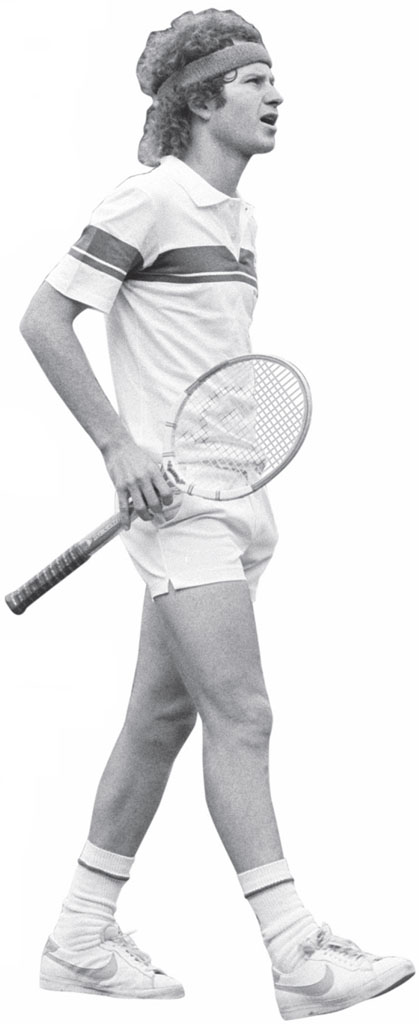
An argument with an umpire can be tactical. Players sometimes have arguments with the umpire to psyche themselves up: ‘They also do it to change the pace of the match. If they’re losing, and the match is going against them, they want a stop in play so they will complain about a line-call just to change up the momentum.’
If you’re concerned about saying too much to the umpire, and you want to control yourself, maybe focus on your racket strings, or turn your chair so you’re facing away from the umpire: ‘You don’t want to be using any foul language with the umpire.’
You can yell. You have to release that anger and get it out of your system, as otherwise you’re not going to play well. You’re going to feel that there’s an injustice there: ‘Staying angry rarely helps you to play better tennis. The only player I’ve seen who has managed his anger, who has even been helped by his anger, is John McEnroe.’

Wimbledon referee Andrew Jarrett on ‘HOW TO DEAL WITH AN ANGRY PLAYER’ …
Treat the player as a responsible adult. Be honest and fair and listen carefully to what is being said: ‘Ultimately, there are rules and sanctions and if you have to enforce them, you will. But hopefully it will be possible to go with a more humane approach first. Try common sense initially. In every rule book, I would suggest that rule number one is “use your common sense”, and only then do you go into the detail.’
Be flexible: ‘There are times to be tough. And there are also times to be a fatherly or brotherly type of figure. You’re dealing with human beings, and everyone is going to react in a different way. There’s not a hard and fast way of dealing with an angry tennis player.’
Always stay within the rules: ‘You’re trying to find a good solution for all concerned. But, from an officiating point of view, you have to find a solution that is within the rules of the sport. That’s life, it can be good, bad or ugly.’

Mohamed Lahyani, who was in the chair for John Isner’s 11-hour victory over Nicolas Mahut at the 2010 Wimbledon Championships, on ‘HOW TO BE A WORLD-CLASS UMPIRE’ …
Do not socialise with the players: ‘We tend to stay in the same hotels as the players, so you will bump into them in the gym or in the lift or in the lobby, and we also take the same cars and buses out to the site. But there are strict rules about not socialising with the players, and especially not one-on-one. Of course, you say hello if you see them away from the courts, but if you had a drink with them in a bar, or a long conversation in a hotel corridor, I think that would look bad. By staying independent, you can make better decisions.’

Have a good breakfast, but do not drink too much coffee: ‘You never know whether you will have time to eat again during the day – I needed a good breakfast for that match at Wimbledon. I will also have a double espresso, but that will be my only coffee of the day. Many of the younger officials seem to think that coffee will keep them sharp, but if you drink too much of it you want to go to the bathroom all the time. If I had gone to the bathroom during that match at Wimbledon, keeping Mahut waiting for several minutes before he served to stay in the tournament yet again, and he had then got broken, I would have got the blame. After Isner had won, the first thing he said to me was: “How did you do that, sitting there in the chair all that time? What’s your secret?”’
You must not drink alcohol within 12 hours of a match, and you can never have a drink if you are still at the tennis: ‘Even if you’re finished for the day, and the last match for the day has just gone on, it is forbidden to have a beer at the site, and I know some officials have lost their jobs over that.’
Do not go on court with any preconceived ideas: ‘You know how some players are on court, as you have studied their personalities, but you have to start every match from scratch, and you must not think, “This guy has been a troublemaker in the past.” You must be fair and treat everyone the same.’
We’re all human and make mistakes, and if you admit to making an error, the players will have greater respect for you. Let angry players speak, and stay calm: ‘Try to calm them down by engaging them in conversation during the changeovers, and by letting them talk, as they will want to have the last word. They want to let off steam, and you want them to feel comfortable on court.’
Players need to be confident and relaxed, and it’s the same for umpires: ‘If you’re confident, you will make better decisions. If you’re tense and nervous, the players will feel it.’
Concentration is key: ‘I don’t think people realise the pressure we are under as umpires, as the players are competing for so much prize money, and there are television cameras everywhere, with the microphones picking up everything you say, and the Hawk-Eye challenge system. If you lose your concentration for half a second and get something wrong, the whole world is going to know about it in half a second, and within ten minutes you’re going to be on YouTube. During that match at Wimbledon, it felt as though every point was a match point.’

Dustin Brown, dreadlocked tennis player who defeated Lleyton Hewitt in the second round of the Wimbledon Championships in 2013, on ‘HOW TO ENTERTAIN A CROWD’ …
If people see that you’re having fun, they are going to enjoy watching you: ‘I try to have as much fun as I can, and I guess people pick up on that.’
There will be nerves beforehand – it’s the same for singers and actors before they go on stage – but once you step on court it’s showtime: ‘You have to get through those nerves as quickly as you can.’
Entertain the crowd, but the primary goal is to win the match: ‘Entertaining people is a bonus.’
John Lloyd, a former British Davis Cup captain, on ‘HOW TO CAPTAIN A TENNIS TEAM’ …
You have to know what makes your players tick. It’s as important for a captain to know his players’ personalities as it is to know their games: ‘You need harmony in the team. Tennis players are often very selfish – it’s an individual sport, and you know how you want to prepare for a match, and how you want to play. So when you put individuals in a team, it’s a very different dynamic. Putting certain characters together in doubles pairings is going to create friction, so you need to be clever about which players you put together.’
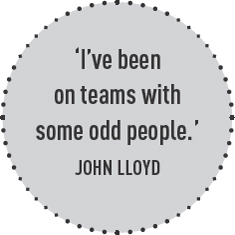
If a player is causing problems, and wrecking team spirit, don’t be afraid to drop them: ‘I’ve been on teams with some odd people before, and you just have to find a way of dealing with those people. But if a player is harming the team morale, that’s different. You have to decide if you really want them to stay around.’

Radek Stepanek, who has won the Davis Cup with the Czech Republic, on ‘HOW TO BE PART OF A TENNIS TEAM’ …
Although some team conversations should remain confidential, it’s always important to be honest, even if that honesty hurts: ‘Probably someone doesn’t want to hear it. But it’s better to get it out there. If someone doesn’t like it, I say that I don’t care, and that I’m just expressing how I feel. And I will say to people that they can tell me their opinions. If you start with a clean table, you can get more done after that. Some opinions can be difficult but it’s not always about being happy and relaxed and having fun. We have fun, but it’s also serious as you’re there to win. It’s not about laughing, but about performing.’
You have to worry about others – for a tennis player, that’s a big change: ‘For me, that was a great thing as I love to be part of a team. I love the atmosphere. You’re taking responsibility for the whole team. And in the Davis Cup you’re taking responsibility for the country.’
To build team spirit, it’s important to have dinner together. No one should have dinner on their own: ‘That helps to bring the different personalities together. Maybe some guys are quiet and are happy in the corner, not talking too much. And there are other guys who like talking the whole time and doing some crazy stuff. You have to find some harmony between the people.’
Work hard. If the team gives everything and you still lose, at least you can say you tried your best: ‘If you lose, it hurts. It always hurts. But if you can wake up in the morning and look in the mirror, and you know that you did everything in your power, then you can’t do any more. When you lose in a situation like that, you shake your opponents’ hands and say, “Well done.” Then you wait for your next chance. But if you don’t give everything, and you lose, that’s going to kill you on the inside.’

Janko Tipsarevic, a former top 10 player, on ‘HOW TO USE THE HAWK-EYE CHALLENGE SYSTEM’ …
It’s not smart to blow all your challenges immediately, just because you think you’re right: ‘Don’t use them up too early. I always try to keep one challenge for the end of a set, especially when it’s a tight match.’
Don’t bother trying to use Hawk-Eye to get a breather or a mental break: ‘I don’t think the extra five seconds you get when Hawk-Eye looks at a line-call is going to give you enough of a break.’

Chris Kermode, Executive Chairman and President of the men’s ATP World Tour, on ‘HOW TO RUN A TENNIS TOURNAMENT’ …
You want to people think, if they’re not there, they’re missing out: ‘That attracts everybody.’
If you start dictating to players what you think is right, you’re going to start alienating people. Everyone wants to be listened to: ‘Ultimately, you’re going to have to make some decisions that won’t appease everybody. But if you’ve gone through the process of listening, most of the time people are happy. Tennis players don’t tend to be stupid. They might have a view, but if you speak to them and explain why you’re doing what you’re doing, 99 per cent of the time they understand.’
If players or spectators are unhappy, don’t start hiding at the back of your office: ‘You need to talk to people and to address the issue head on.’
There must be a social element to it: ‘People are incredibly busy, and demands on people’s time – work, family – are pretty intense, and there are so many different sporting and entertainment events which are trying to get your time and money. So the event has to be enjoyable and good value.’

Former Wimbledon head groundsman Eddie Seward on ‘HOW TO HAVE A LAWN LIKE CENTRE COURT’ …
Work on the grass the whole year round: ‘We cut it throughout the year. Many people make the mistake of letting out a big sigh of relief in September, and putting the mower in the shed for another year, and thinking that they don’t need to cut their lawn again until the spring.’
Punch holes into the court to get some air into it: ‘This allows the roots to develop in the autumn.’
If you’re top-dressing the court with soil, you should do some analysis to make sure it’s compatible with what’s already there: ‘You need to make sure it’s the same soil all the way through.’
Scarify the lawn [rake out the moss and thatch] in the autumn: ‘This is one thing that people often don’t do – they think that it’s going to cause a big mess. They are then making a bigger problem for themselves, as they are getting a lot of thatch, and the court becomes very soft and spongy and therefore the ball won’t bounce very much.’
Keep urban foxes and pigeons away from the lawn: ‘If a vixen gets on to the court and urinates, that kills the grass and kills the soil. Pigeons and other birds will eat the seeds, and the sulphur in their droppings will burn the grass a little bit. The ammonia in the droppings can also make your courts look like they have measles. At Wimbledon, we fly a hawk three times a week, which keeps pigeons away.’
